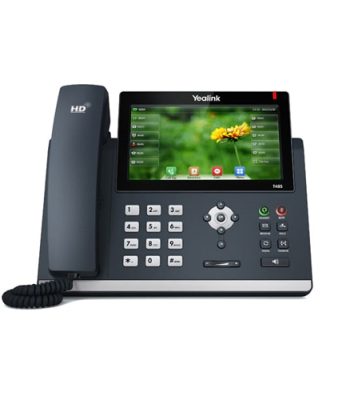Description
Yealink T41 is an enterprise VoIP desk phone for everyone. T41 gives you six line appearances and four context-sensitive soft keys. Yealink has upgraded the T41, now including support for the adaptable Opus codec. The Optima HD Voice handset has been updated to be HAC (hearing aid compatible), giving beautiful wideband audio for everyone. The full-duplex speakerphone with AEC (acoustic echo cancellation) provides wideband audio hands-free. Connect a headset via the RJ9 port, or use the RJ12 port for EHS with the EHS36 wireless headset adapter. The USB 2.0 port provides Bluetooth or WiFi functionality when you plug in the appropriate dongle (support pending).
Yealink T41 has dual 10/100 Ethernet ports with pass-through and PoE support. The 2.7″ monochrome display has a bright backlight and clear LCD graphics to let you choose your desired actions easily. Yealink SIP-T41 includes advanced security features like HTTPS support, AES encrypted XML configuration file and TLS/SSL communications. The T41 includes a desk stand and is wall-mountable with an optional wall mounting kit.
Specifications
Audio Features
> HD voice: HD handset, HD speaker
> Hearing aid compatible (HAC) handset
> Wideband codec: Opus*, G.722
> Narrowband codec: Opus*, G.711(A/µ), G.723.1, G.729AB, G.726, iLBC
> Full-duplex hands-free speakerphone with AEC
Phone Features
> 6 VoIP accounts
> One-touch speed dial, redial
> Call forward, call waiting
> Call transfer, call hold
> Call return, group listening
> Mute, auto answer, DND
> 3-way conference call
> Direct IP call without SIP proxy
> Ring tone selection/import/delete
> Hotline, emergency call
> Set date time manually or automatically
> Dial plan, XML Browser, Action URL/URI
> RTCP-XR (RFC3611), VQ-RTCPXR (RFC6035)
> USB port (2.0 compliant):
Bluetooth earphone through BT40,
Wi-Fi through WF40,
USB call recording through USB flash drive
> Enhanced DSS key
Directory
> Local phonebook up to 1000 entries
> Black list
> XML/LDAP remote phonebook
> Smart dialing
> Phonebook search/import/export
> Call history: dialed/received/missed/forwarded
IP-PBX Features
> Busy Lamp Field (BLF)
> Bridged Line Apperance (BLA)
> Anonymous call, anonymous call rejection
> Hot-desking, voice mail
> Flexible seating
> Call park, call pickup
> Executive and Assistant
> Centralized call recording
> Visual voice mail
> Call recording
Display and Indicator
> 2.7″ 192×64-pixel graphical LCD with backlight
> LED for call and message waiting indication
> Dual-color (red or green) illuminated LEDs for line status information
> Intuitive user interface with icons and soft keys
> Multilingual user interface
> Caller ID with name and number
> Power saving
Feature keys
> 6 line keys with LED
> 6 line keys can be programmed up to 15 paperless DSS keys (3-page view)
> 5 features keys: message, headset, mute, redial, hands-free speakerphone
> 4 context-sensitive “soft” keys
> 6 navigation keys
> 2 volume control keys
> Illuminated mute key
> Illuminated headset key
> Illuminated hands-free speakerphone key
Interface
> Dual-port 100Mbps Ethernet
> Power over Ethernet (IEEE 802.3af), Class 2
> 1 x USB port (2.0 compliant)
> 1 x RJ9 (4P4C) handset port
> 1 x RJ9 (4P4C) headset port
> 1 x RJ12 (6P6C) EHS port
Other Physical Features
> Stand with 2 adjustable angles
> Wall mountable
> External Yealink AC adapter (optional):AC 100~240V input and DC 5V/1.2A output
> Power consumption (PSU): 1.69-5.0W
> Power consumption (PoE): 2.47-12.5W
> Dimension (W*D*H*T): 212mm*189mm*175mm*54mm
> Operating humidity: 10~95%
> Operating temperature: -10~50°C
Management
> Configuration: browser/phone/auto-provision
> Auto provision via FTP/TFTP/HTTP/HTTPS for mass deploy
> Auto-provision with PnP
> Zero-sp-touch, TR-069
> Phone lock for personal privacy protection
> Reset to factory, reboot
> Package tracing export, system log
Network and Security
> SIP v1 (RFC2543), v2 (RFC3261)
> Call server redundancy supported
> NAT traversal: STUN mode
> Proxy mode and peer-to-peer SIP link mode
> IP assignment: static/DHCP
> HTTP/HTTPS web server
> Time and date synchronization using SNTP
> UDP/TCP/DNS-SRV(RFC 3263)
> QoS: 802.1p/Q tagging (VLAN), Layer 3 ToS DSCP
> SRTP for voice
> Transport Layer Security (TLS)
> HTTPS certificate manager
> AES encryption for configuration file
> Digest authentication using MD5/MD5-sess
> OpenVPN, IEEE802.1X
> IPv6
> LLDP/CDP/DHCP VLAN
> ICE









